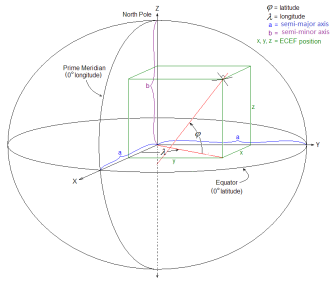
Back Coordenades geocèntriques Catalan ECEF Czech Geozentrisches Koordinatensystem German Coordenadas geocéntricas Spanish سامانه مختصات زمینمرکز، زمینایستا Persian Distance géocentrique French ECEF HE Geosentrik ID ECEF Italian Geosentrik JV

| Geodesy |
|---|
 |
The Earth-centered, Earth-fixed coordinate system (acronym ECEF), also known as the geocentric coordinate system, is a cartesian spatial reference system that represents locations in the vicinity of the Earth (including its surface, interior, atmosphere, and surrounding outer space) as X, Y, and Z measurements from its center of mass.[1][2] Its most common use is in tracking the orbits of satellites and in satellite navigation systems for measuring locations on the surface of the Earth, but it is also used in applications such as tracking crustal motion.
The distance from a given point of interest to the center of Earth is called the geocentric distance, R = (X2 + Y2 + Z2)0.5, which is a generalization of the geocentric radius, R0, not restricted to points on the reference ellipsoid surface. The geocentric altitude is a type of altitude defined as the difference between the two aforementioned quantities: h′ = R − R0;[3] it is not to be confused for the geodetic altitude.
Conversions between ECEF and geodetic coordinates (latitude and longitude) are discussed at geographic coordinate conversion.
- ^ Leick, Alfred (2004). GPS Satellite Surveying. Wiley.
- ^ Clynch, James R. (February 2006). "Earth Coordinates" (PDF). Archived from the original (PDF) on April 18, 2015.
- ^ Chobotov, V.A. (2002). Orbital Mechanics. AIAA Education Series. American Institute of Aeronautics & Astronautics. p. 72. ISBN 978-1-60086-097-3. Retrieved October 24, 2021.
© MMXXIII Rich X Search. We shall prevail. All rights reserved. Rich X Search